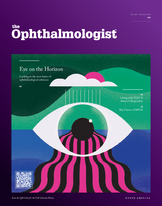
“The Art of Ophthalmology” issue has been running since The Ophthalmologist first opened its eyes in 2014. Showcasing artwork from individuals in the ophthalmic field, the feature bridges the gap between medicine and art. This year, we have made a concerted effort to feature artwork created by visually impaired (VI) artists, re-focusing the lens on individuals directly affected by the shifting field of ophthalmology.
Putting together this issue – and having the pleasure to sift through a variety of unique artworks created by ophthalmologists and VI artists alike – has really spurred me to think about the scope of accessibility in art. Do galleries do enough to ensure the artwork they display is representative of all creatives? Do museums and galleries do enough to ensure their exhibits are accessible to visitors with disabilities? Although institutions such as The Museum Of Modern Art offer touch tours, audio tours, and programs for people with a range of disabilities, this isn’t reflective of the art world at large (1). According to audio description (AD) provider, VocalEyes, only three percent of UK museums and galleries mention AD guides on their websites and, where available, they are often infrequent and require advance booking (2).
This opens a door into the wide variety of work created by VI artists – talented individuals who, far from being creatively constrained by their impairments, are instead inspired, using an array of colors, textures, and forms to convey their unique experiences of the world. One such example comes from the legally blind comic book illustrator, Douglas Knight, whose illustration, “The Surge” – displaying a gentleman at a crosswalk gripping a cane – serves as a celebration of Knight’s own mobility orientation training.
If museums and galleries can do more to promote artwork created by not just VI artists, but artists with all disabilities, perhaps there will be a shift in how these organizations operate. As stated in a recent article on accessibility, “There is a pressing need to devisualize the museum [...] to move away from the ableist assumption that vision is the primary sense through which heritage and museums should be experienced (2).”
As professionals dedicated to preserving or restoring sight– but with a clear awareness of what it means for people to suddenly or gradually lose their vision – I’m keen to learn your perspective: [email protected]
- The New York Times, “Making Art Accessible for All” (2023). Available at: https://nyti.ms/3q5KQiT.
- A F Eardley, “Devisualizing the Museum: From Access to Inclusion,” Journal of Museum Education, 47, 150 (2022).
Communicating stories in a way that is accessible to all was one of the focal points of my Creative Writing degree. Although writing magical realism is a fun endeavor (and one I still dabble in), getting to the heart of human stories has always been the driving motivator behind my writing. At Texere, I am able to connect with the people behind scientific breakthroughs and share their stories in a way that is impactful and engaging.













